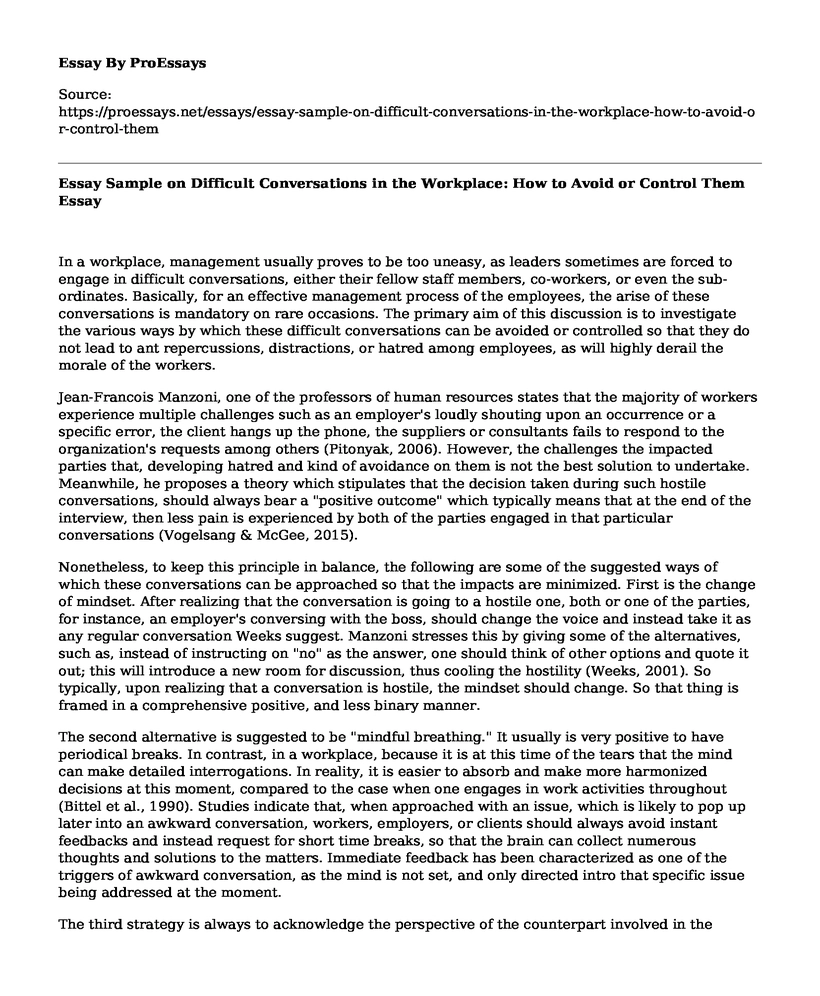In a workplace, management usually proves to be too uneasy, as leaders sometimes are forced to engage in difficult conversations, either their fellow staff members, co-workers, or even the sub-ordinates. Basically, for an effective management process of the employees, the arise of these conversations is mandatory on rare occasions. The primary aim of this discussion is to investigate the various ways by which these difficult conversations can be avoided or controlled so that they do not lead to ant repercussions, distractions, or hatred among employees, as will highly derail the morale of the workers.
Jean-Francois Manzoni, one of the professors of human resources states that the majority of workers experience multiple challenges such as an employer's loudly shouting upon an occurrence or a specific error, the client hangs up the phone, the suppliers or consultants fails to respond to the organization's requests among others (Pitonyak, 2006). However, the challenges the impacted parties that, developing hatred and kind of avoidance on them is not the best solution to undertake. Meanwhile, he proposes a theory which stipulates that the decision taken during such hostile conversations, should always bear a "positive outcome" which typically means that at the end of the interview, then less pain is experienced by both of the parties engaged in that particular conversations (Vogelsang & McGee, 2015).
Nonetheless, to keep this principle in balance, the following are some of the suggested ways of which these conversations can be approached so that the impacts are minimized. First is the change of mindset. After realizing that the conversation is going to a hostile one, both or one of the parties, for instance, an employer's conversing with the boss, should change the voice and instead take it as any regular conversation Weeks suggest. Manzoni stresses this by giving some of the alternatives, such as, instead of instructing on "no" as the answer, one should think of other options and quote it out; this will introduce a new room for discussion, thus cooling the hostility (Weeks, 2001). So typically, upon realizing that a conversation is hostile, the mindset should change. So that thing is framed in a comprehensive positive, and less binary manner.
The second alternative is suggested to be "mindful breathing." It usually is very positive to have periodical breaks. In contrast, in a workplace, because it is at this time of the tears that the mind can make detailed interrogations. In reality, it is easier to absorb and make more harmonized decisions at this moment, compared to the case when one engages in work activities throughout (Bittel et al., 1990). Studies indicate that, when approached with an issue, which is likely to pop up later into an awkward conversation, workers, employers, or clients should always avoid instant feedbacks and instead request for short time breaks, so that the brain can collect numerous thoughts and solutions to the matters. Immediate feedback has been characterized as one of the triggers of awkward conversation, as the mind is not set, and only directed intro that specific issue being addressed at the moment.
The third strategy is always to acknowledge the perspective of the counterpart involved in the conversation. Week states that, before acting on a problem, an individual should first ask to understand where the problem is and what the other party thinks the problem is. It all shows the caring ability to the other partner (Stone et al., 2010). After getting into coincidence and understanding everyone's thoughts on the cause of difficulty and the actual problem, the parties can then determine the point of overlap and then address one issue concurrently. Misunderstanding is one of the significant factors with a high potential of triggering or driving regular conversations into difficult ones.
References
Bittel, L. R., Newstrom, J. W., & Newstrom, J. (1990). What every supervisor should know: the complete guide to supervisory management (p. 582). McGraw-Hill.
Pitonyak, D. (2006). The importance of belonging. TASH Connections, 32(1-2), 1-3. Retrieved from http://www.iimhl.com/files/docs/20140130a.pdf
Stone, D., Heen, S., & Patton, B. (2010). Difficult conversations: How to discuss what matters most. Penguin.
Vogelsang, J. D., & McGee, S. (2015). Handbook for facilitating difficult conversations in the classroom. Queens, NY: City University of New York, Queens College. Retrieved February 7, 2019.
Weeks, H. (2001). Taking the stress out of stressful conversations. Harvard business review, 79(7), 112-120. Retrieved from https://provost.tufts.edu/celt/files/Taking-the-Stress-Out-of-Stressful-Conversations-by-Weeks.pdf
Cite this page
Essay Sample on Difficult Conversations in the Workplace: How to Avoid or Control Them. (2023, Mar 29). Retrieved from https://proessays.net/essays/essay-sample-on-difficult-conversations-in-the-workplace-how-to-avoid-or-control-them
If you are the original author of this essay and no longer wish to have it published on the ProEssays website, please click below to request its removal:
- The Strategic Developments of Airline Business Models Past, Present and the Future
- Components of a Business Plan Paper Example
- Big Bark Toys Case Study Paper Example
- Sustainable Change Essay Example
- Essay on Leadership Studies in Theology: Scripture-Based, God-Governed, Christ-Centric
- Project Selection Using Scoring Model: Assessing Weighted Values - Essay Sample
- Paper Sample on Adapting to Change: Overcoming Challenges in the Business World







